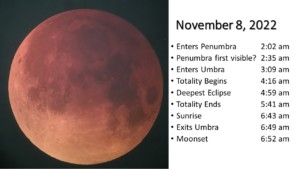November Beaver Mini-Moon Total Eclipse, November 8, 2022
Earlier this week featured a total lunar eclipse, the second this year, visible from the United States. This was a pre-dawn celestial event with the moon setting just after, or during, the final phases of partial eclipse (depending on which part of the country it was observed). We hosted a gathering of 25 students and 5 faculty at the Prairie View Observatory on Monday evening November 7 for a pre-eclipse telescope viewing session. The Moon was bright and full in the eastern sky, with Jupiter high in the south southeast and Saturn medium high in the south southwest. These were the targets viewed with four telescopes: a wide field view of the Full Moon (especially easy to take cellphone images through) with the Takahashi 5.1-inch refractor; a close-up view with the Meade 10-inch Cassegrain; and the planets through our 10″ Dob reflectors, one looking at Jupiter and another viewing Saturn.
The graphic below provides the circumstances for the eclipse, with times listed in CST. The image at left is from last May’s total lunar eclipse.
All of the images below were made afocally (taken through the eyepiece) with a Samsung Galaxy 21 smart phone in pro mode or night imaging mode, exposure times ranged from 1/500 second to 2 seconds at ISO 400. The telescope was a University-owned CPC 1100 (11-inch f/10 Cassegrain, with 41 mm eyepiece). The times of each image are listed in Coordinated Universal Time, or UTC, where CST = UTC – 6 hours.
After the Moon entered the penumbra (the fuzzy outer part of a shadow) at 8:02 UTC, the eclipse is invisible at first. Then, 35 to 40 minutes after this event, the first hint of shading appears on one side of the Moon. It is very subtle and hard to see, but it gradually gets darker and darker (as shown in the two images below) in the last 20 minutes before first contact with the umbra (the dark core or main part of the shadow, which marks the start of partial eclipse), which happened at 9:09 UTC.
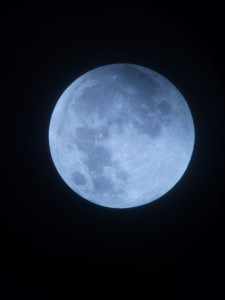 8:52:21 UTC, 50 minutes after first penumbra contact. 8:52:21 UTC, 50 minutes after first penumbra contact. |
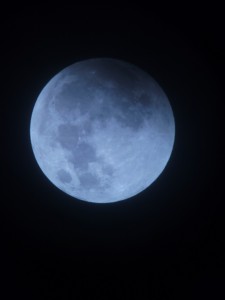 9:03:14 UT, less than six minutes before first umbral contact. 9:03:14 UT, less than six minutes before first umbral contact. |
The first of six images below show that the penumbral shading can be quite obvious in the last few minutes before partial eclipse begins.
For the next 67 minutes after the start of partial eclipse, the Moon steadily slips deeper into the dark umbra shadow. Even with only about a third of the Moon covered in shadow, the moonlit surroundings are noticeably dimmer. By about 50% immersion, the part of the Moon in shadow can be seen, even with the naked eye. It looks like a ruddy version of the earthshine phenomena that is commonly seen when the Moon is a thin crescent. Binoculars bring out the colors more. The progression of the partial phases is summarized in the six images below. The exposures are short to emphasize the overall visual appearance of the Moon as it gets deeper into the umbra.
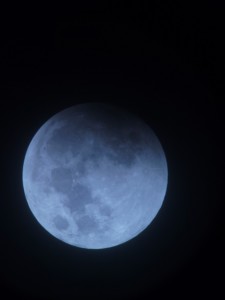 9:07:24 UTC 9:07:24 UTC |
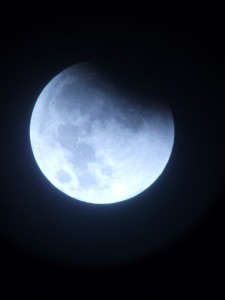 9:16:51 UTC 9:16:51 UTC |
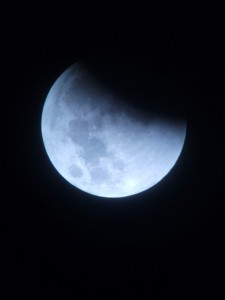 9:26:17 UTC 9:26:17 UTC |
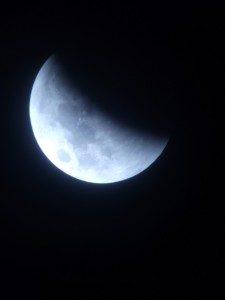 9:38:26 UTC 9:38:26 UTC |
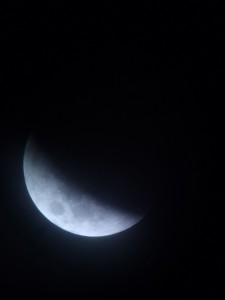 9:53:58 UTC 9:53:58 UTC |
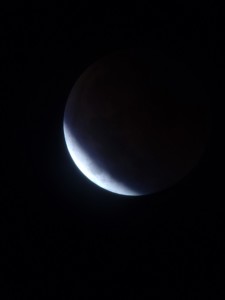 10:07:15 UTC 10:07:15 UTC |
It is always interesting to watch the transition from one phase of the eclipse to the next, especially through a telescope with a wide field of view that allows the entire moon to be seen. Totality began at 10:16 UT, so the first two images below are actually very deep partial phases, moments before the onset of totality, when the entire Moon lies inside the umbra shadow.
It can also be interesting to see how different settings in imaging can result in different color balances in the results. The “night mode” produced more orange-colored eclipse images. The “pro mode” showed more of a pinkish hue, which I also noticed visually. Overall the Moon glowed softly in shades of orange, but with a hint of pink overall. The images were taken at various times throughout the 85 minutes of totality. Maximum / Mid-eclipse (when the Moon is deepest in the umbra, and thus darkest) was at 10:59 UT.
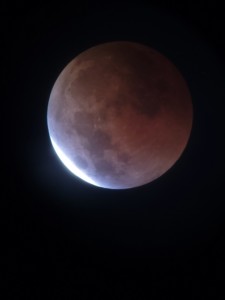 10:12:48 UTC 10:12:48 UTC |
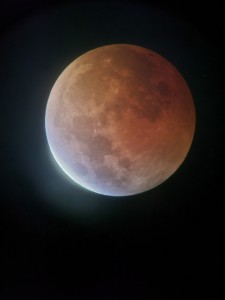 10:13:10 UTC. 10:13:10 UTC. |
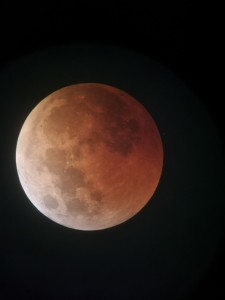 10:22:04 UTC 10:22:04 UTC |
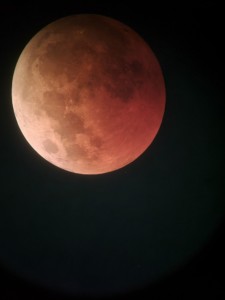 10:34:52 UTC 10:34:52 UTC |
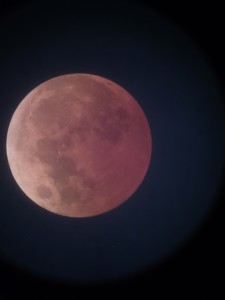 10:49:34 UTC 10:49:34 UTC |
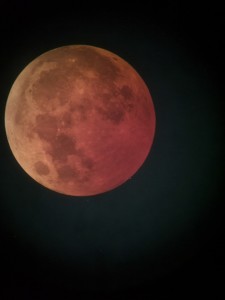 10:59:51 UTC-mid-eclipse 10:59:51 UTC-mid-eclipse |
Nearing the end of Totality, which occurred at 11:41 UT. As this event neared, one side of the Moon became noticeably brighter and brighter, until it returned to sunlight. The last of the four images below was taken about a minute after end of totality.
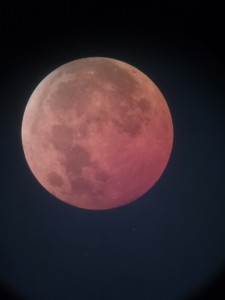 11:16:10 UTC 11:16:10 UTC |
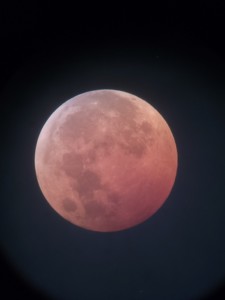 11:30:31 UTC. 11:30:31 UTC. |
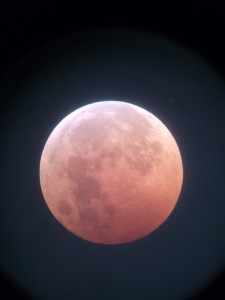 11:38:37 UTC. 11:38:37 UTC. |
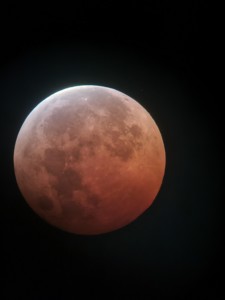 11:42:33 UTC. 11:42:33 UTC. |
The partial phases as the Moon moves out of the Earth’s shadow… As the Moon got lower in the sky, I needed to change to a smaller, more portable personal telescope, a 4.5-inch f/8 reflector. This needed to be moved to various locations as the Moon sank behind houses and other obstructions. The images below were taken through the eyepiece of this instrument.
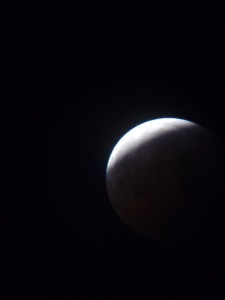 11:53:38 UTC. 11:53:38 UTC. |
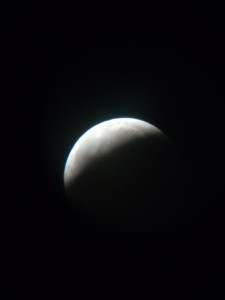 12:01:02 UTC 12:01:02 UTC |
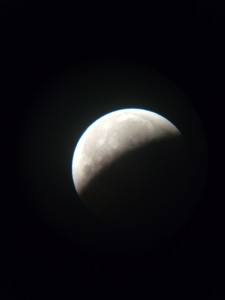 12:09:31 UTC. 12:09:31 UTC. |
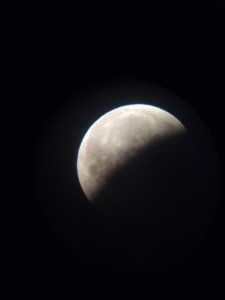 12:13:55 UTC. 12:13:55 UTC. |
My last view of the Moon for this event was at 12:24 UT through a space in the trees. It was still 25 minutes short of exiting the umbra and about two-thirds in sunlight. Actual moonset was about three minutes after the end of the partial phases, or nine minutes after local sunrise.
The next total eclipse visible from the United States will happen March 14, 2025.

